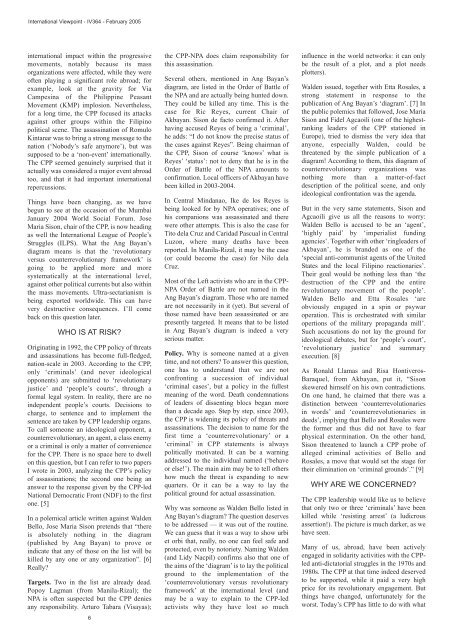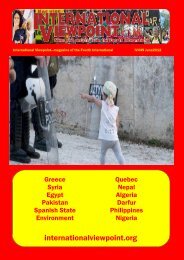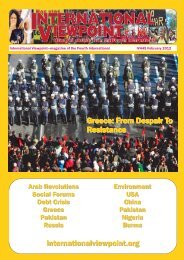IV 364 - International Viewpoint
IV 364 - International Viewpoint
IV 364 - International Viewpoint
You also want an ePaper? Increase the reach of your titles
YUMPU automatically turns print PDFs into web optimized ePapers that Google loves.
<strong>International</strong> <strong>Viewpoint</strong> - <strong>IV</strong><strong>364</strong> - February 2005<br />
international impact within the progressive<br />
movements, notably because its mass<br />
organizations were affected, while they were<br />
often playing a significant role abroad; for<br />
example, look at the gravity for Via<br />
Campesina of the Philippine Peasant<br />
Movement (KMP) implosion. Nevertheless,<br />
for a long time, the CPP focused its attacks<br />
against other groups within the Filipino<br />
political scene. The assassination of Romulo<br />
Kintanar was to bring a strong message to the<br />
nation (‘Nobody’s safe anymore’), but was<br />
supposed to be a ‘non-event’ internationally.<br />
The CPP seemed genuinely surprised that it<br />
actually was considered a major event abroad<br />
too, and that it had important international<br />
repercussions.<br />
Things have been changing, as we have<br />
begun to see at the occasion of the Mumbai<br />
January 2004 World Social Forum. Jose<br />
Maria Sison, chair of the CPP, is now heading<br />
as well the <strong>International</strong> League of People’s<br />
Struggles (ILPS). What the Ang Bayan’s<br />
diagram means is that the ‘revolutionary<br />
versus counterrevolutionary framework’ is<br />
going to be applied more and more<br />
systematically at the international level,<br />
against other political currents but also within<br />
the mass movements. Ultra-sectarianism is<br />
being exported worldwide. This can have<br />
very destructive consequences. I’ll come<br />
back on this question later.<br />
WHO IS AT RISK?<br />
Originating in 1992, the CPP policy of threats<br />
and assassinations has become full-fledged,<br />
nation-scale in 2003. According to the CPP,<br />
only ‘criminals’ (and never ideological<br />
opponents) are submitted to ‘revolutionary<br />
justice’ and ‘people’s courts’, through a<br />
formal legal system. In reality, there are no<br />
independent people’s courts. Decisions to<br />
charge, to sentence and to implement the<br />
sentence are taken by CPP leadership organs.<br />
To call someone an ideological opponent, a<br />
counterrevolutionary, an agent, a class enemy<br />
or a criminal is only a matter of convenience<br />
for the CPP. There is no space here to dwell<br />
on this question, but I can refer to two papers<br />
I wrote in 2003, analyzing the CPP’s policy<br />
of assassinations; the second one being an<br />
answer to the response given by the CPP-led<br />
National Democratic Front (NDF) to the first<br />
one. [5]<br />
In a polemical article written against Walden<br />
Bello, Jose Maria Sison pretends that “there<br />
is absolutely nothing in the diagram<br />
(published by Ang Bayan) to prove or<br />
indicate that any of those on the list will be<br />
killed by any one or any organization”. [6]<br />
Really?<br />
Targets. Two in the list are already dead.<br />
Popoy Lagman (from Manila-Rizal); the<br />
NPA is often suspected but the CPP denies<br />
any responsibility. Arturo Tabara (Visayas);<br />
6<br />
the CPP-NPA does claim responsibility for<br />
this assassination.<br />
Several others, mentioned in Ang Bayan’s<br />
diagram, are listed in the Order of Battle of<br />
the NPA and are actually being hunted down.<br />
They could be killed any time. This is the<br />
case for Ric Reyes, current Chair of<br />
Akbayan. Sison de facto confirmed it. After<br />
having accused Reyes of being a ‘criminal’,<br />
he adds: “I do not know the precise status of<br />
the cases against Reyes”. Being chairman of<br />
the CPP, Sison of course ‘knows’ what is<br />
Reyes’ ‘status’: not to deny that he is in the<br />
Order of Battle of the NPA amounts to<br />
confirmation. Local officers of Akbayan have<br />
been killed in 2003-2004.<br />
In Central Mindanao, Ike de los Reyes is<br />
being looked for by NPA operatives; one of<br />
his companions was assassinated and there<br />
were other attempts. This is also the case for<br />
Tito dela Cruz and Caridad Pascual in Central<br />
Luzon, where many deaths have been<br />
reported. In Manila-Rizal, it may be the case<br />
(or could become the case) for Nilo dela<br />
Cruz.<br />
Most of the Left activists who are in the CPP-<br />
NPA Order of Battle are not named in the<br />
Ang Bayan’s diagram. Those who are named<br />
are not necessarily in it (yet). But several of<br />
those named have been assassinated or are<br />
presently targeted. It means that to be listed<br />
in Ang Bayan’s diagram is indeed a very<br />
serious matter.<br />
Policy. Why is someone named at a given<br />
time, and not others? To answer this question,<br />
one has to understand that we are not<br />
confronting a succession of individual<br />
‘criminal cases’, but a policy in the fullest<br />
meaning of the word. Death condemnations<br />
of leaders of dissenting blocs began more<br />
than a decade ago. Step by step, since 2003,<br />
the CPP is widening its policy of threats and<br />
assassinations. The decision to name for the<br />
first time a ‘counterrevolutionary’ or a<br />
‘criminal’ in CPP statements is always<br />
politically motivated. It can be a warning<br />
addressed to the individual named (‘behave<br />
or else!’). The main aim may be to tell others<br />
how much the threat is expanding to new<br />
quarters. Or it can be a way to lay the<br />
political ground for actual assassination.<br />
Why was someone as Walden Bello listed in<br />
Ang Bayan’s diagram? The question deserves<br />
to be addressed — it was out of the routine.<br />
We can guess that it was a way to show urbi<br />
et orbi that, really, no one can feel safe and<br />
protected, even by notoriety. Naming Walden<br />
(and Lidy Nacpil) confirms also that one of<br />
the aims of the ‘diagram’ is to lay the political<br />
ground to the implementation of the<br />
‘counterrevolutionary versus revolutionary<br />
framework’ at the international level (and<br />
may be a way to explain to the CPP-led<br />
activists why they have lost so much<br />
influence in the world networks: it can only<br />
be the result of a plot, and a plot needs<br />
plotters).<br />
Walden issued, together with Etta Rosales, a<br />
strong statement in response to the<br />
publication of Ang Bayan’s ‘diagram’. [7] In<br />
the public polemics that followed, Jose Maria<br />
Sison and Fidel Agcaoili (one of the highestranking<br />
leaders of the CPP stationed in<br />
Europe), tried to dismiss the very idea that<br />
anyone, especially Walden, could be<br />
threatened by the simple publication of a<br />
diagram! According to them, this diagram of<br />
counterrevolutionary organizations was<br />
nothing more than a matter-of-fact<br />
description of the political scene, and only<br />
ideological confrontation was the agenda.<br />
But in the very same statements, Sison and<br />
Agcaoili give us all the reasons to worry:<br />
Walden Bello is accused to be an ‘agent’,<br />
‘highly paid’ by ‘imperialist funding<br />
agencies’. Together with other ‘ringleaders of<br />
Akbayan’, he is branded as one of the<br />
‘special anti-communist agents of the United<br />
States and the local Filipino reactionaries’.<br />
Their goal would be nothing less than ‘the<br />
destruction of the CPP and the entire<br />
revolutionary movement of the people’.<br />
Walden Bello and Etta Rosales ‘are<br />
obviously engaged in a spin or psywar<br />
operation. This is orchestrated with similar<br />
opertions of the military propaganda mill’.<br />
Such accusations do not lay the ground for<br />
ideological debates, but for ‘people’s court’,<br />
‘revolutionary justice’ and summary<br />
execution. [8]<br />
As Ronald Llamas and Risa Hontiveros-<br />
Baraquel, from Akbayan, put it, “Sison<br />
skewered himself on his own contradictions.<br />
On one hand, he claimed that there was a<br />
distinction between ‘counterrevolutionaries<br />
in words’ and ‘counterrevolutionaries in<br />
deeds’, implying that Bello and Rosales were<br />
the former and thus did not have to fear<br />
physical extermination. On the other hand,<br />
Sison threatened to launch a CPP probe of<br />
alleged criminal activities of Bello and<br />
Rosales, a move that would set the stage for<br />
their elimination on ‘criminal grounds’.” [9]<br />
WHY ARE WE CONCERNED?<br />
The CPP leadership would like us to believe<br />
that only two or three ‘criminals’ have been<br />
killed while ‘resisting arrest’ (a ludicrous<br />
assertion!). The picture is much darker, as we<br />
have seen.<br />
Many of us, abroad, have been actively<br />
engaged in solidarity activities with the CPPled<br />
anti-dictatorial struggles in the 1970s and<br />
1980s. The CPP at that time indeed deserved<br />
to be supported, while it paid a very high<br />
price for its revolutionary engagement. But<br />
things have changed, unfortunately for the<br />
worst. Today’s CPP has little to do with what









